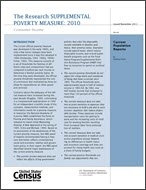The Research SUPPLEMENTAL POVERTY MEASURE: 2010
The Research SUPPLEMENTAL POVERTY MEASURE: 2010
Introduction
The current official poverty measure was developed in the early 1960s, and only a few minor changes have been implemented since it was first adopted in 1969 (Orshansky, 1963, 1965a, 1965b; Fisher, 1992). This measure consists of a set of thresholds for families of different sizes and compositions that are compared to before-tax cash income to determine a family’s poverty status. At the time they were developed, the official poverty thresholds represented the cost of a minimum diet multiplied by three (to allow for expenditures on other goods and services).
Concerns about the adequacy of the official measure have increased during the past decade (Ruggles, 1990), culminating in a congressional appropriation in 1990 for an independent scientific study of the concepts, measurement methods, and information needs for a poverty measure. In response, the National Academy of Sciences (NAS) established the Panel on Poverty and Family Assistance, which released its report titled Measuring Poverty: A New Approach in the spring of 1995, (Citro and Michael, 1995). Based on its assessment of the weaknesses of the current poverty measure, this NAS panel of experts recommended having a measure that better reflects contemporary social and economic realities and government policy. In their report, the NAS panel identified several major weaknesses of the current poverty measure.
Others in Series
Publication
Publication
Publication




